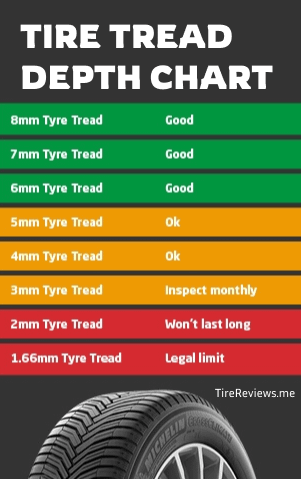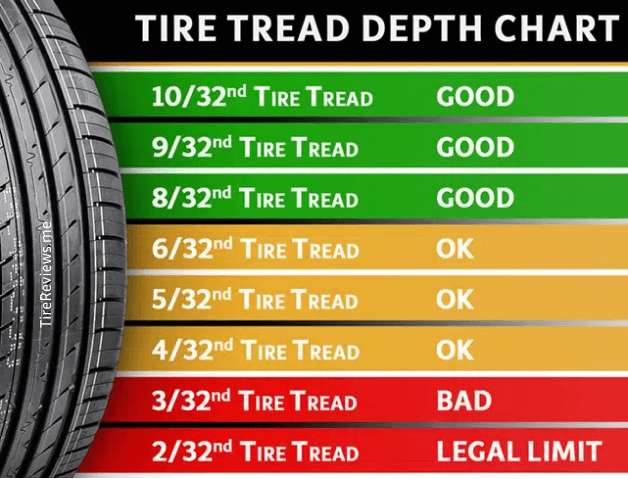
The tire tread depth chart is a valuable tool for vehicle owners, providing important information about the condition of their tires. In this comprehensive guide, we will explore the significance of tire tread depth and how to interpret the tire tread depth chart. Understanding and monitoring tire treads using this chart is essential for maintaining road safety and optimizing vehicle performance.
Interpreting the Tire Tread Depth Chart:
The tire tread depth chart presents measurements in both 32nds of an inch and millimeters (mm). This dual-unit approach caters to the varying measurement systems used worldwide, ensuring its applicability to a wide range of users. By referring to the chart, you can easily determine the current tread depth of your tires and understand its implications.
| TIRE TREAD | METRIC | STATUS |
|---|---|---|
| 10/32″ | 8mm | GOOD |
| 9/32″ | 7mm | GOOD |
| 8/32″ | 6mm | GOOD |
| 6/32″ | 5mm | OK |
| 5/32″ | 4mm | OK |
| 4/32″ | 3mm | Inspect Monthly |
| 3/32″ | 2mm | Wont’t last long |
| 2/32″ | 1.66mm | LEGAL LIMIT! |

Why is the Tire Tread Depth Chart Important?
The tire tread depth chart serves as a reference guide for assessing the condition of your tires. It provides a visual representation of different tread depth levels, allowing you to determine if your tires are in good, acceptable, or critical condition. By referencing this chart, you can make informed decisions about tire replacement and ensure optimal road grip and safety.
Significance of Different Tread Depth Levels:
The tire tread depth chart classifies tread depths into various categories, each with its own significance:
- Good Tread Depth:
- Tread Depths: 10/32″ (8mm), 9/32″ (7mm)
- Status: These depths indicate good tire condition, providing excellent traction and performance.
- Acceptable Tread Depth:
- Tread Depth: 8/32″ (6mm)
- Status: Tires at this depth are considered acceptable, though slightly reduced grip may be experienced in wet conditions.
- Tread Depth Requiring Attention:
- Tread Depths: 6/32″ (5mm), 5/32″ (4mm)
- Status: Tires at these depths are approaching the minimum threshold and require closer monitoring, particularly in adverse weather conditions.
- Tread Depth Requiring Regular Inspection:
- Tread Depth: 4/32″ (3mm)
- Status: Tires at this depth should be inspected monthly to ensure their continued safety and performance.
- Low Tread Depth:
- Tread Depth: 3/32″ (2mm)
- Status: Tires at this depth won’t last long and should be replaced promptly to ensure safe driving.
- Minimum Legal Tread Depth:
- Tread Depth: 2/32″ (1.66mm)
- Status: This depth represents the legal limit for tire tread in many regions. Tires at or below this level must be replaced immediately to comply with regulations and ensure road safety.
Commercial truck tire tread depth chart
According to the regulations set by the Federal Motor Carrier Safety Administration (FMCSA), the minimum tread depth for commercial truck tires is as follows:
- Steer tires, which are the tires on the front wheels, must have a minimum tread depth of 4/32 of an inch.
- Every other tire on the vehicle must have a minimum tread depth of 2/32 of an inch.
To provide the equivalent tread depth in millimeters, new truck tires typically have an average tread depth of 8 to 9 millimeters, which is approximately 10/32 to 11/32 of an inch. As you drive and use the tires, the tread will gradually wear down. It is important to note that once the tread depth falls below 1.6 millimeters or 2/32 of an inch, the tire’s grip is significantly reduced. This reduction in grip can negatively impact braking distance and overall vehicle control.
Conclusion
The tire tread depth chart is an invaluable tool for vehicle owners, enabling them to assess the condition of their tires accurately. By referencing the chart and understanding the significance of different tread depth levels, you can make informed decisions regarding tire replacement and prioritize road safety. Regularly monitoring and maintaining proper tire tread depth is essential for optimal traction, vehicle performance, and overall safety. Utilize the tire tread depth chart to ensure your tires are always in good condition and enjoy safe and confident driving experiences.